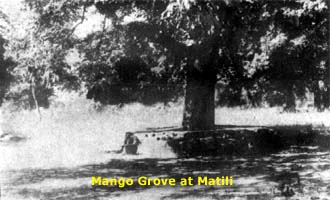Hanging of Laxman Naik: A Tribal Gandhite
The siege of Matili police station was a part of the 1942 August Revolt. Matili was then under Malkangiri Tahasil.On 21st August 1942, people from neighbouring villages moved towards Matili in streams. They were flaunting congress flag and chanting Ramdhun and in intervals raising the slogan 'victory to Mahatma Gandhi". Patriotism was in full display. It was about half past nine in the morning when about one thousand people had assembled in an open space near the market place. Laxman briefly described the agenda of the day. That they would proceed to Matili police station and hold meeting in front of it.They would hoist the Congress flag on the top of the police station. They would squat until their arrest .He instructed every body not to resort to any violence even under the provocation by the police. March started. Laxman led the procession with the Congress tricolour flag in the hand. Anticipating such gathering an elaborate police arrangement had been made. So before the procession led by Laxman could reach the police station, on the way it was intercepted by police and was forced to return to the market place again. In the market place Laxman again addressed to the gathering explaining them the meaning of independence and how it would lead to the abolition of the practice of bonded labour and would mean everything , the villages, forests and fields, the police station, revenue office etc., belonged to them. They again proceeded towards the police station but only to face this time the armed police personnel at the entrance of the police station. Being face to face, a minor scuffle ensued between the demonstrators and the police personnel. The demonstrators committed to their resolution of not resorting to any violence did not hit back the police though the police had already had lathicharged the demonstrators. Laxman was dragged by the police and was mercilessly beaten. His moustache was burnt. The demonstrators were at their wits end. Their beloved leader Laxman Naik was being tortured. The sight was unbearable to the demonstrators. They tried to force their way into the Police Station. At this stage police opened fire Yet the Congress workers held to their ground, they could not be frightened. In stead two persons from the procession tried to hoist the flag atop the police station but were shot dead by the police. They were Linga Bhumia and Nakul Madkami. Many more died in the police firing along with them died the forest guard G. Ramayya, an opium addict who was on the day of firing was not in his senses and therefore had strayed into the crowd at the receiving end of the firing. But Ramayya's death was seized by the administration as a unique opportunity to implicate Laxman as murderer of Ramayya. The administration succeeded. A votary of nonviolence and himself at the time of firing lying unconscious, Laxman Naik was held as prime accused. He was sentenced to death by Sessions Court. In between his death sentence by the sessions court and appeal against it lying in the High Court, Laxman had written a letter to one Mr. Radha Charan Das, Advocate wherein he pleaded his innocence. He wrote:
But all such appeals and pleadings failed. The High Court confirmed the death sentence. It became inevitable that a believer of nonviolence had to meet the violence of power. In Berhampur jail Laxman Naik was hanged to death. It was Monday, 29 March 1943. Manmohan chaudhuri, veteran freedom fighter and son of Gopabandhu Chaudhuri who was in Berhampur jail at the time of Laxman Nayak’s hanging, describes the night before the hanging in his autobiography (in Oriya) Kasturi Mruga Sama as follows:
The appeal in the High Court did not succeed. The day of hanging was fixed to be 29th March 1943. on the previous day, the Jailer conducted a search of all the wards, lest there might be weapons in any ward. Even the implements of the carpenters were taken away. All the wards were locked; prisoners stayed in the locked rooms. Scarcely one would have slept in that night. It was a night of bad dreams. The educated cultured people would kill one of our compatriots cold-blooded and we would be helpless witnesses to it; we were revolting inside. But what was the way out; the violence that had over taken the nation and its people was manifesting in naked form. May be to revolt would have occurred to some. Later, somewhere, in a meeting of workers Nabakrushna Choudhury broke down while recalling the hanging of Laxman Naik and said, "We are all cowards. We should have tried to save Laxman Naik". Such attempt would never have succeeded but it would have been a protest and an expression of the concern of agitated souls. It would have served as a burning example and as a source of inspiration for the future generation. But this did not happen. Instead, they suppressed their anger and anguish and resolved to root out the rulers who had killed Laxman Naik. The elder brother of Lenin was sentenced to death on the charges of attempt to murder the Czar. Lenin, in protest, did not lay his life. He resolved to root out the Czar rule and to establish a new society. He more or less succeeded. But how long we could remember the feelings of that night? How far we could take the resolve of that black night? We got Swaraj- the power of self-rule. Those who were witness to that black night, many of them turned out to be blood suckers for the people whom Laxman represented. Ramnathan, who had pronounced the death sentence without any reliable evidence against Laxman Naik, but at the behest of the orders from the top, later became the blue eyed boy of the Congress Government of Independent India. The day before hanging, Laxman Naik wanted to meet Sadashiv Tripathy, a Cogress Leader of Koraput district. Sadashiv was taken to Laxman. Laxman said to him," Sir, I am leaving. Are we really going to get the power of self-rule, the Swaraj? Will people live in peace?" Sadashiva replied in a choked voice," Oh! Surely. Should there be any doubt about it?" Laxman Naik said, " Victory to Mahatma Gandhi". Throughout the night we were hunted by scaring thoughts, the details leading to his hanging were crossing the mind. Every small sound was enough to break our sleep. Was 4.00AM struck? That was the hour scheduled for Laxman’s hanging. Before that Laxman would be given bath. Then his hands would be tied behind and he would be led by four warders almost running towards scaffold. He would be made to stand on the platform. A longish cap would cover his head. There would be present surrounding him the officials of the district administration, police superintendent, civil surgeon, jail superintendent, jailer, two external witnesses, jail doctor, police constables, warder etc. Then the noose would be dropped to be tightened around his neck. All care would have been taken as per the jail manual such that hanging did not fail Laxman. At the schedule moment the jail superintendent would wave a handkerchief for the hangman to operate the handle. The hangman would obey the order. The noose around Laxman’s neck would shrink till the neck bone broke and Laxman hanged to death. The hangman in Berhampur jail was the jailer himself, one Mr. Rao. In jails under Madras Presidency Law provided the jailer as executioner. As Berhampur was earlier in Madras Presidency, this practice was in vogue in Berhampur jail. Mr. Rao would be executing Laxman Naik for which he would be rewarded with twenty-five or thirty rupees, a bottle of wine and one day holiday for consuming alcohol. We all got up from sleep at about 3.00AM, sat for prayer. Some political prisoners were in the cell adjacent to Laxman’s cell. After some time a feeble voice was heard from that cell. Then Baidyanath in our cell raised the slogan ‘ Inquilab Zindabad". The slogan echoed in the entire jail. The slogan went on being endlessly repeated carrying all anguish, all anxieties, and all the tears as if the entire jail was crying. The scaffold was hardly 50 cubits from the gate of our ward. We could hear the sound of a fall. The slogan was however continuing. My father in choked voice said, " Why again? He can’t hear any more. Laxman Naik was arrested on the charges of leading a gherao of the Mathili Police Station on 21.8.1942 that led to the death of a forest guard Rageya. The case registered against him and his 53 other compatriots bore the Case No.58/1942. They were first tried in the Court of the Deputy Magistrate Somanath Mishra and were found guilty of the charges and the case was transferred to the Sessions Court in September 1942. They were brought from Jaypore jail to Koraput Jail. After two months hearing the Additional Sessions Judge V.Ramanathan passed the judgment on 13.11,1942 as follows:
Findings of the Judge: Accused No.1 is found guilty u/s 302 I.P.C, 147 I.P.C. u/s.5 D.I.Rule 35 D.I.Rules. Accused No.2-10, 12-17, 19, 22-54 are found guilty u/s 302 I.P.C read with section 149 I.P.C., 147 I.P.C., and under rule 35 D.I.Rules. Accused Nos.11, 18,20 and 21 not found guilty. Sentence or Order: Accused No.1 Shrri Lokhan Naiko is convicted under Section 302 I.P.C and sentenced to death subject to confirmation by the Hon'ble High Court. He is also convicted under Section 147 I.P.C. of committing a prejudicial act under Rule 38(5)D.I. Rule and of approaching the Police Station Mathili with intent to damage it under Rule 35 Defense of India Rules and is convicted of these offence and no separate sentence is passed. Accused Nos. 2-10, 12-17, 19, 22-54 are convicted under Section 302 I.P.C read with 149 I.P.C and each sentenced to transportation for life. They are convicted u/s 147 I.P.C and each sentenced to R.I. for 2(two) years. They are also convicted u/s 35 of the Defence India Rules and sentenced to R.I. for seven years each. All the above sentences will run concurrently. Accused Nos. 11, 18, 20, 21 are found guilty of the charges tried against them and acquitted to the same and they are directed to be set at liberty unless they are required to answer any other charges. (Rao Saheb A. Appalaswamy Naidu, Public Prosecutor, Koraput District, Jaypore conducted the prosecution and Shri R. Jagannadha Rao, advocate Jaypore defended the accused persons having been engaged by the Crown) Laxman Naik was sentenced to death whereas 49 of his compatriots were awarded life imprisonment and the rest four. |
Photograph Source : as in References
References :
-
Lakshman Naik A Study in Tribal Patriotism by Nihar Ranjan Patnaik, Academy of Tribal Dialects and Culture, 1992
-
Dhuli Matira Santha (in Oriya), by Gopinath Mohanty, 1983
-
Kasturi Mrugasama (in Oriya) by Manmohan Chaudhury









